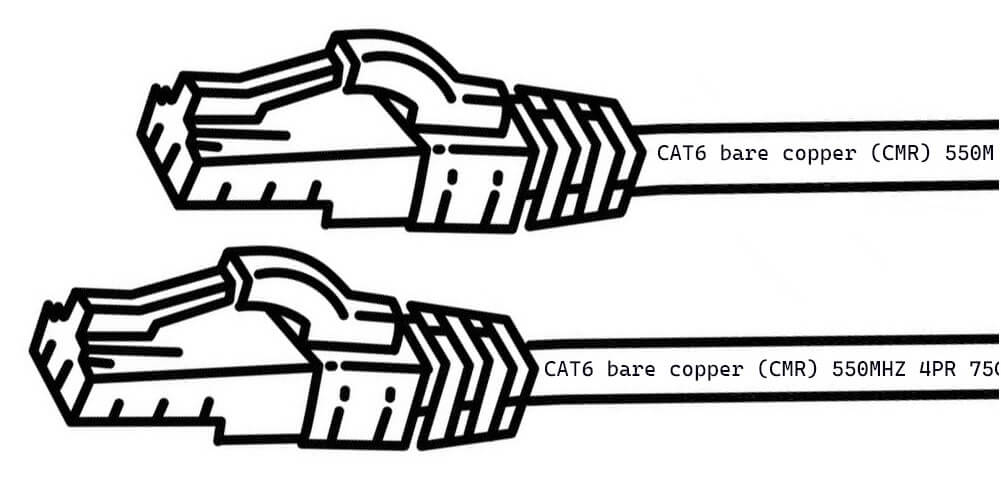How To Tell Which Type of Ethernet Cable You Have
When it comes to Ethernet cables, there are various types in today’s market. If you are not an expert, you might need some help to know what type of Ethernet cable you have. The easiest way to find out is by reading the codes on the cable jacket. In this article, we will go over the various codes or markings printed on the cable to help you identify your Ethernet cable.
Cable Jacket Ledger And What those Markings Mean
Let’s begin by discussing the cable jacket since it holds the key to understanding your Ethernet cable. If you look at your cable, you will find that it is imprinted with letters, numbers, codes and other information. These imprinted markings are called the “cable jacket ledger”.

The ledger identifies various important information such as; manufacturer or UPC code, cable category, jacket material, electrical standards, temperature rating, material rating, etc. This information will tell you exactly what type of Ethernet cable you have and most importantly, where the cable can be installed.
Here you will find an overview of common markings and codes that can be imprinted on a typical Ethernet jacket.
Manufacturer:
This is the company name who produced the cable. It is good to know in case you have any questions about the cable.
Product Name:
This tells you the exact name of the specific cable product. (i.e.: Cat6 UTP Patch Cable)
Category:
On the cable jacket it will indicate what Category cable you have such as; Cat5e, Cat6, Cat6a, Cat7 and Cat8. Each category cable has different data transfer speeds, bandwidth and distance ratings.
These cables can come in both shielded and unshielded and its conductor can be pure copper or copper-clad aluminum. Below is a brief description of each.
| Category | Standard Bandwidth | Max Data Rate | Shielding |
|---|---|---|---|
| Cat5 | 100MHz (up to 350) | 100 Mbps | UTP or FTP |
| Cat5e | 100MHz (up to 350) | 1,000 Mbps / 1 Gbps | UTP or FTP |
| Cat6 | 250MHz (up to 550) | 1,000 Mbps / 1 Gbps | UTP or FTP |
| Cat6a | 250MHz (up to 550) | 10,000 Mbps / 10 Gbps | UTP or FTP |
| Cat7 | 600MHz | 10,000 Mbps / 10 Gbps | Shielded |
| Cat7a | 1000MHz | 40,000 Mbps/ 40 Gbps | Shielded |
| Cat8 | 2000MHz | 25 Gbps or 40 Gbps | Shielded |
Do you know what are the most common Category Ethernet cables used in today’s market? Cat5e, Cat6 and Cat6a
UTP or FTP
After the Category, the next grouping of code is usually either UTP (unshielded twisted pair) or FTP (shielded twisted pair). Depending on which of these abbreviations are on your cable, will determine how much crosstalk or attenuation will be present and where the cable can be installed.
You might find that some cables will have S/FTP or F/UTP, which means that it is shielded or unshielded in certain areas of the cable. In the case of F/UTP, the wires are unshielded and have an aluminum foil shielding that surrounds the whole cable.
This helps to block out any interference from other cables that may cause signal loss. As for S/FTP, it has a screen of braided aluminum surrounding the cable, as well as a foiled twisted pair, which creates more layers of protection for the cable to prevent signal leakage.
Gauge (AWG) / Conductor Size
The wire gauge marking known as American Wire Gauge (AWG) signifies the diameter or size of each conductor wire. (i.e.: 24AWG is the gauge for “Cat5e). The higher the number, the thinner the conductor will be.
Bandwidth
This marking tells you the bandwidth in MHz of the cable. For example, a Cat6 cable has a 550 MHz bandwidth frequency. It tells you how fast data is transmitted in a cable.
Number of Pairs (4P)
This marking indicates the number of twisted pairs in the cable (i.e.: “4PR” or “2PR”, etc.)
Cable Certifications / Standard Compliance
These codes show two important certifications to ensure an Ethernet cable adheres to the safety and performance standards required.
-UL
The UL (formerly known as “Underwriters Laboratories”) means that it has undergone the extensive testing necessary to be in compliance with legal standards. It also determines in what applications the cable is safe to be used for. On some cables you may find the word Verified right after UL. This indicates that the cable has been verified to comply with the regulations.
-TIA/EIA
This lets you know the coloring order requirements (i.e.: TIA/EIA 568B) for the conductors inside the cable. For telephone and network cables, the TIA/EIA indicates the order to put the conductors when crimping connectors or punching down to a block.
Material Class/Fire Ratings
-CL/CM/CMG:
These cable jacket markings indicate that they are suitable for use in ordinary applications that are low-voltage and can be installed in walls or ceilings. It also indicates that they have passed the “vertical tray flame test” which means they shouldn’t spread flames more than eight feet in the event of a fire.
A CL rated cable is usually used for audio/visual applications. It also comes rated CL2 or CL3, which refers to the voltage it carries (i.e.: CL2-150 volts, CL3-300 volts). These cables do not reduce the emission of smoke and gases, but do minimize the possibility of getting an electric shock.
A CM/CMG rated cable is for general use in Ethernet communications applications and can be used in walls and beneath floors or other areas without fire code restrictions.
-CMR
This rating indicates a riser cable that can be applied in risers of commercial buildings. They are designed to reduce the spread of flames and can be installed anywhere except in plenum spaces.
The CL2R and CL3R are riser versions of the CL2 and CL3 but these carry higher voltages.
-CMP
This rating indicates a plenum cable that can be applied in plenum spaces such as a drop ceiling or raised floor system and also anywhere a CM or CMR can be applied. Its insulated jacket is fire-resistant and can reduce flame spread to no more than five feet. It also limits the emission of harmful toxic smoke and has the ability to self-extinguish.
Temperature rating:
This marking refers to the cable’s maximum temperature rating (i.e.: 75 degrees C). If it should go above that temperature for extended periods of time, the cable materials can slowly degrade and affect its performance. This is especially true for outdoor installations where temperatures fluctuate and can be a concern. In this situation, you would want outdoor cabling rated specifically to withstand varying temperatures and is moisture resistant.
RoHS:
This marking indicates that the manufacturer of the cable followed the Restriction of Hazardous Substances (RoHS) guidelines. These guidelines originated in the European Union to restrict the use of hazardous materials found in electrical and electronic products or equipment. This guideline is also referred to as the “lead-free directive”, although it encompasses a total of 10 restricted substances including lead.
Conclusion
Although this is not a comprehensive list by far, it does provide you with enough information to be able to tell what type of cable you have and where it can be installed. Also, it’s important to note, not all cables will have the same information on them as every Ethernet cable is different in some way.
If you have any questions about your cable that we have not covered here, please feel free to visit our website at satmaximum.com where we have other articles that may be helpful to you.













































